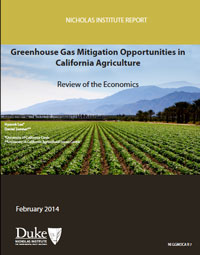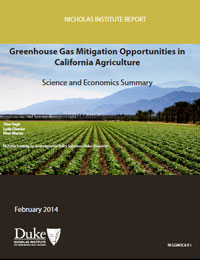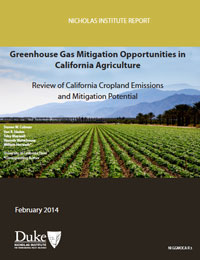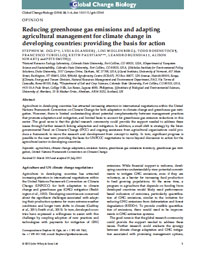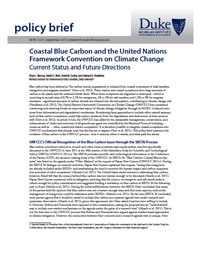Publications
Greenhouse Gas Mitigation Opportunities in California Agriculture: Science and Economics Summary
California Assembly Bill 32 requires effective statewide greenhouse gas (GHG) reduction strategies. This report summarizes the results of six studies--developed to inform California policy--that review the latest science and economics of GHG mitigation opportunities in California's agricultural sector. Specifically, the report examines the potential for annual GHG reductions in cropland, rangeland, and manure management systems and through emissions-targeted optimization of feed for dairy animals. Among the examined practices, dairy manure management appears to provide the largest emissions reduction opportunity at the lowest cost per ton, but economic and other hurdles must be overcome to realize it. Other mitigation activities could yield relatively large per-acre reductions but on relatively small acreage. Yet other activities could be widely implemented, but their potential effectiveness is uncertain. More data on the GHG reduction potential and costs of management practices in California agriculture and a better understanding of adoption barriers are needed.
Greenhouse Gas Mitigation Opportunities for California Agriculture: Review of the Economics
Although about three-quarters of California farm revenue derives from crop production, crops—mainly tree, vine, and vegetable crops—account for only about one-quarter of GHG emissions. Some studies indicate minimal yield loss from reducing nitrogen fertilizer use, and simulation results show significant percentage reductions in GHG emissions for payments of $20/MTCO2e. The economics of reducing emissions from enteric fermentation has been little studied. Manure management to reduce GHG emissions (mainly methane) can be as simple as covering manure lagoons and flaring methane. The more complex option of using manure-generated methane gas to replace fossil fuels has been investigated often. Most case studies and simulations suggest this option is costly. Its economic feasibility depends on specific local conditions, but there is no evidence of large-scale feasibility in California without large subsidies.
Greenhouse Gas Mitigation Opportunities for California Agriculture: Outlook for California Agriculture to 2030
California agriculture is diverse and complex, producing several dozen major crop and livestock commodities using the state’s great spatial variation of natural and climate resources and well-developed infrastructure of input delivery systems, processing systems, and marketing services. What, where, and how these commodities are produced reflect biophysical, economic, and policy drivers, all of which have and will continue to change. This report examines the statewide greenhouse gas (GHG) emissions and emissions mitigation potential of alternative futures for California agriculture through 2030. It finds that the dairy industry in California has by far the largest GHG emissions of all the state’s agricultural production systems but that the industry’s growth trajectory is uncertain. Three potential growth scenarios suggest that baseline dairy emissions could decrease by as much as 20% or increase by as much as 40% (almost one-quarter of the entire agricultural sector’s current emissions). This variation in baseline emissions projections may be as large as or larger than the industry’s emissions mitigation potential.
Greenhouse Gas Mitigation Opportunities for California Agriculture: Review of California Cropland Emissions and Mitigation Potential
Agriculture contributes approximately 7% of California’s total greenhouse gas (GHG) emissions; less than 3% of the state total comes from croplands. Efforts to reduce California’s agricultural GHG emissions from croplands will require sound information regarding how specific agricultural management practices impact those emissions over the landscape. A review of agricultural literature was conducted on studies that quantified GHG emissions in California annual and perennial croplands. This report reviews the available scientific literature relevant to GHG emissions from California croplands and quantitatively assesses the biophysical potential of various agricultural mitigation strategies relevant to California cropping systems. A total of 20 studies were identified, relating to 10 specific management practices in California croplands. Where possible, data from these studies were used to estimate the biophysical mitigation potential of various agricultural management practices. This work revealed that 3 of the 10 management practices—farmland preservation, expansion of perennial crops, and manipulation of nitrogen fertilizer rates—have high to medium relative mitigation potential. However, reliably estimating the biophysical mitigation potential of these practices is not possible at this time due to many uncertainties and lack of information. Relatively few field studies conducted in California rigorously examine GHG emissions from changes in agricultural management activities and practices. Thus, more research is needed to inform future management and policy alternatives.
Reducing Greenhouse Gas Emissions and Adapting Agricultural Management for Climate Change in Developing Countries: Providing the Basis for Action
Agriculture in developing countries has attracted increasing attention in international negotiations within the United Nations Framework Convention on Climate Change (UNFCCC) for both adaptation to climate change and greenhouse gas mitigation. However, there is limited understanding about potential complementarity between management practices that promote adaptation and mitigation, and limited basis to account for greenhouse gas emission reductions in this sector. The good news, the authors write in the journal Global Change Biology, is that the global research community could provide the support needed to address these issues through further research linking adaptation and mitigation. In addition, a small shift in strategy by the Intergovernmental Panel on Climate Change and ongoing assistance from agricultural organizations could produce a framework to move the research and development from concept to reality. In turn, significant progress is possible in the near term providing the basis for UNFCCC negotiations to move beyond discussion to action for the agricultural sector in developing countries.
Environmental Leadership: A Reference Handbook
Researchers at the Nicholas Institute for Environmental Policy Solutions contributed to a chapter in the publication "Environmental Leadership: A Reference Handbook." The book covers topics that confront the particular intractable characteristics of environmental problem solving. Individual chapters focus on how environmental leadership actions or initiatives may be applied to address specific problems in context, offering both analyses and recommendations.
Operationalizing REDD+: Scope of Reduced Emissions from Deforestation and Forest Degradation
This paper discusses the operational issues associated with the expanding scope of reduced emissions from deforestation (RED) as forest degradation, conservation and enhancement of forest carbon stocks (REDD+) and other sectors and activities are added. The review looks to the ideas of countries, observers, and experts, as well as to the experience of those moving toward implementation through country REDD+ plans and voluntary offset markets. While not all countries may be ready to implement programs or policies across all REDD+ activities, expanding RED to REDD+ can bring significant benefits for strategic planning, coordination across sectors and activities, and increasing mitigation opportunities.
Incorporating Blue Carbon as a Mitigation Action under the United Nations Framework Convention on Climate Change: Technical Issues to Address
Coastal and marine ecosystems store large amounts of carbon in soil sediments and vegetation. When these systems are disturbed through conversion or degradation, this emits carbon dioxide, a greenhouse gas whose growing atmospheric concentration is altering the climate system. Attention to this source of “blue carbon” emissions has only, fairly recently, been motivated by new scientific studies quantifying its magnitude. The United Nations Framework Convention on Climate Change (UNFCCC), as part of its mission to reduce threats to our global climate system, promotes the sustainable management, conservation, and enhancement of sinks and reservoirs of all greenhouse gases, including those in coastal marine ecosystems. Yet there are no specific mechanisms within the UNFCCC that focus on blue carbon. This paper reviews where coastal marine ecosystems and blue carbon may be addressed within existing UNFCCC mechanisms, such as those dealing with land use and reduced emissions from deforestation and degradation (REDD+), at the project and national levels.
Coastal Blue Carbon and the United Nations Framework Convention on Climate Change: Current Status and Future Directions
Blue carbon has been defined as “the carbon stored, sequestered or released from coastal ecosystems of tidal marshes, mangroves and seagrass meadows.” These marine and coastal ecosystems store large amounts of carbon in the plants and the sediment below them. When these ecosystems are degraded or destroyed, significant amounts of carbon dioxide are released into the atmosphere, contributing to climate change risk. The United Nations Framework Convention on Climate Change (UNFCCC) has considered conserving and restoring forests an important aspect of climate change mitigation through its REDD+ (reduced emissions from deforestation and degradation) mechanism. Broadening these approaches to include other natural systems, such as blue carbon ecosystems, could help reduce emissions from the degradation and destruction of these areas as well. This policy brief examines the evolution of blue carbon in the UNFCCC process—how it entered, where it stands, and what path lies ahead.
Estimating Global "Blue Carbon" Emissions from Conversion and Degradation of Vegetated Coastal Ecosystems
Recent attention has focused on the high rates of annual carbon sequestration in vegetated coastal ecosystems—marshes, mangroves, and seagrasses—that may be lost with habitat destruction. Relatively unappreciated, however, is that conversion of these coastal ecosystems also impacts very large pools of previously-sequestered carbon. Residing mostly in sediments, this ‘blue carbon’ can be released to the atmosphere when these ecosystems are converted or degraded. Here we provide the first global estimates of this impact and evaluate its economic implications. Combining the best available data on global area, land-use conversion rates, and near-surface carbon stocks in each of the three ecosystems, using an uncertainty-propagation approach, we estimate that 0.15–1.02 billion tons of carbon dioxide are being released annually, several times higher than previous estimates that account only for lost sequestration.


